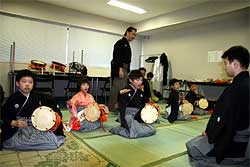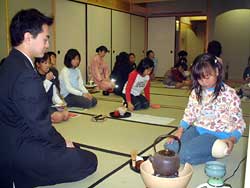|
WHAT'S COOL IN JAPAN More and More Kids Learn Traditional Arts | ||||||||||||
Outside of school, many Japanese kids take lessons in things like piano, English conversation, and swimming. But lately some have also been getting into traditional Japanese arts like the tea ceremony and shamisen (a three-stringed instrument like a guitar). Why are these kids so interested in these ancient arts? Their parents are partly responsible. A growing number of parents are encouraging their kids to take these lessons because they want them to experience traditional culture. Schools are partly responsible, too. In 2002, traditional Japanese musical instruments were added to the junior-high-school music curriculum. One person who has a close-up view of this trend is Okura Shonosuke, who teaches children the traditional performance art of noh. Noh is a form of drama combining dancing, singing, and music. Mr. Okura is a drum player of the Okura school of noh music. Over the past 20 years he has visited kindergartens, elementary schools, and middle schools all over Japan. He has held over 100 workshops giving kids the opportunity to play taiko drums, hand drums, flutes, and other traditional Japanese musical instruments. His workshops enable kids to learn about noh first-hand.
Mr. Okura really enjoys working with the kids and loves seeing their reactions to the new experiences. "Sometimes a kid will let out a big yell, pound the drum, be surprised by the sound, pound the drum again, and let out a big laugh," he says. "A lot of adults think that traditional Japanese musical instruments and noh songs are too difficult for children to learn. But when they actually give it a try, they really seem to enjoy it and they have great powers of concentration. They enjoy it just as much as they enjoy modern pastimes like video games or soccer. I even once had a third-grader tell me that the first time he played a taiko drum, he felt a timeless presence." In March 2005, Mr. Okura and other noh experts were the instructors at a workshop called Children's Noh Challenge 2005. The workshop attracted 50 kids from elementary-school to high-school age. After about 10 practice sessions where they learned real noh music and performances, the students gave a recital at Tokyo Metropolitan Art Space. "I'd like to create an environment in which kids have easy access to traditional Japanese musical instruments and singing, both at school and at home," says Mr. Okura.
The tea ceremony is also becoming more popular among children. The Otonashi Seinenbu group from the Sado Urasenke organization (Urasenke school of tea ceremony) holds "challenge tea ceremonies" each year around Tokyo's Kita Ward. At these events, children enjoy drinking tea and eating sweets, as well as actually trying their hands at preparing tea. And from June to December 2004 a children's tea ceremony course was held, in which 21 boys and girls aged from 6 to 15 got to experience practicing the tea ceremony and making Japanese sweets. "During practice, the children's concentration was very impressive. I thought they were able to sense time flowing in a meaningful way quite different than what they are used to in their daily lives," said Tsubaki Katsumi, deputy director of Otonashi Seinenbu. One participant, an elementary-school third grader, talked about her experiences: "I want to remember what I learned through the tea ceremony: 'Treasure every encounter, for it will only ever occur once,' [This is a tea-ceremony teaching meaning that during a tea ceremony, you should think of it as a once in a lifetime opportunity and make a sincere effort] and become the kind of person who pays attention even to small things." More and more kids are getting the opportunity to experience the fun and the depth of traditional Japanese culture. |


